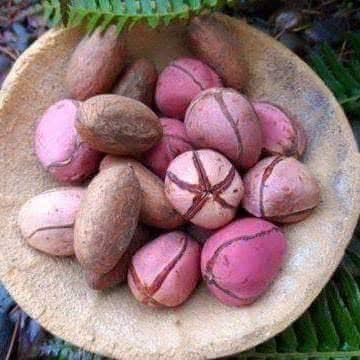The Igbo people of Nigeria are known for their rich culture, deep traditions, and strong sense of community. One of their most respected and symbolic practices is the kola nut ritual. While it may seem simple from the outside, this tradition holds deep meaning. It represents honor, togetherness, and the unbreakable bond between the living and the ancestors.
In this blog, we’ll explore what the kola nut means in Igbo culture, how the ritual is performed, and why this age-old tradition still matters today — even among younger generations and in modern Igbo families living abroad.
What Is the Kola Nut?
The kola nut is the fruit of the kola tree, which grows in parts of West Africa. It’s usually reddish-brown, oval in shape, and has a tough outer shell. Inside, you’ll find one or more lobes — each part carrying deep spiritual meaning in Igbo beliefs. Though it tastes bitter, the kola nut is a treasured symbol in Igbo culture.
Locally called ọjị, this fruit is not eaten casually. It’s offered with care and reverence, especially during important events like:
- Traditional marriage introductions and weddings
- Naming ceremonies for newborns
- Funerals and ancestral remembrance
- Community meetings or dispute settlements
- Visits from respected guests or elders
In all these moments, the kola nut acts as a sacred messenger — connecting people with the spirits, the ancestors, and each other.
Why Is the Kola Nut Ritual Important? (Iwa Oji)
The kola nut isn’t just offered for show. It speaks a language of its own. Here’s why the ritual matters deeply in Igbo society:
1. A Sign of Welcome and Respect
When someone visits your home, offering the kola nut is like saying, “I welcome you not just into my home, but into my heart.” It’s the first gesture before any conversation, meal, or business. Failing to offer it could be seen as disrespect or bad luck.
2. A Bridge to the Ancestors
Igbo people believe the ancestors are still present, watching over the living. Through prayers offered during the kola nut ritual, they are invited to bless the occasion, offer protection, and guide the gathering.
3. A Symbol of Unity
During the ritual, everyone receives a piece of the kola nut. This act breaks down social barriers — age, gender, or class. Everyone is equal in that moment. It’s a quiet reminder that we all belong to one family or community.
4. A Marker of Serious Occasions
Without a kola nut ritual, many Igbo people feel a ceremony hasn’t truly begun. It sets the spiritual tone and shows the event carries weight — whether it’s a joyful celebration or a solemn funeral.
5. A Way to Keep Culture Alive
For many, the kola nut ritual is their first lesson in Igbo values: hospitality, patience, prayer, and tradition. It’s a teaching tool passed down from elders to the youth, helping to preserve the culture even in modern times.
How Is the Kola Nut Ritual Performed? (Iwa Oji)
While there are slight variations across Igbo communities, the basic process of performing the kola nut ritual follows a familiar pattern.
Here’s how it usually goes:
1. Presentation of the Kola Nut
The host, usually the eldest male or titled person, brings out the kola nut and places it in front of the guests. It’s usually placed on a special tray or clean cloth. The display itself shows honor and readiness to begin.
2. Prayers and Blessings
The person presenting the kola nut offers prayers — calling on the ancestors, the creator (Chukwu), and spiritual forces for blessings. These prayers often include wishes for peace, long life, good health, prosperity, and unity among those present.
3. Breaking the Kola Nut
The kola nut is then broken by hand or cut open with a small knife. Elders pay close attention to the number of lobes inside. This number is said to carry divine messages:
- 2 lobes: Duality — balance between good and evil
- 3 lobes: Less favored — seen as incomplete or unbalanced
- 4 lobes: Most desirable — symbolizes wholeness, blessings, and good fortune
In some parts of Igbo land — including my own village — the number of kola nuts brought to an event also holds cultural meaning. During traditional marriages, burials, or community events, the host is often required to present specific counts of kola nuts, such as four or eight. These numbers are not chosen at random. They represent deeper traditional symbols, especially the four market days in Igbo land: Eke, Orie, Afor, and Nkwo. This shows how each community keeps tradition alive through symbolic numbers and rituals.
4. Sharing the Pieces
The kola nut is shared with everyone present. It’s important to accept it with the right hand — a sign of honor and cultural awareness. Even if someone doesn’t want to chew it, accepting it shows participation in the ritual.
5. Eating the Kola Nut
Despite its bitterness, many people chew the kola nut out of respect. Some may just hold it. Eating it isn’t mandatory — honoring the ritual is what matters most.
6. Closing Prayers
The ceremony ends with a short prayer or thanksgiving. The elder may thank the ancestors for their presence and call for a peaceful and successful gathering. After this, the main event can begin — whether it’s a meeting, wedding, or celebration.
The Kola Nut Beyond Ritual: In Daily Life
The kola nut isn’t just limited to formal occasions. It plays important roles in everyday traditional Igbo life.
1. Conflict Resolution
When disputes arise between families, friends, or neighbors, elders often begin reconciliation talks by presenting a kola nut. This sets the tone for peace and sincerity.
2. Naming Ceremonies
When a child is born, elders offer kola nuts during naming ceremonies. It’s a prayer for long life and strong roots in the community.
3. In Marriage Rites
At every stage of Igbo traditional marriage — from introduction to the main ceremony — kola nuts must be presented. In many villages, there’s a specific number the groom’s family must bring. In my village, for example, they may bring four or eight kola nuts to honor tradition. These numbers often symbolize things like the four native market days, a core part of Igbo cultural identity. Without these numbers, the ceremony may be seen as incomplete or improper.
4. Funerals and Memorials
Even in grief, kola nuts are offered. They serve as a sign of respect to the departed and an invitation for ancestors to receive the soul and comfort the living.
The Symbolism Behind the Kola Nut
Every part of the kola nut ritual holds deeper meaning:
1. The Lobes
Four lobes bring good luck. Two lobes symbolize balance. Three is traditionally avoided. This shows how seriously people take divine signs in their everyday lives.
2. The Brown Color
It stands for earth and life itself — a reminder that we all come from the soil and return to it.
3. The Bitter Taste
Life has its challenges. The bitterness is a reminder to be strong, patient, and wise through all of life’s trials.
4. The Circular Shape
Just like a circle, life goes on. The kola nut’s round shape reminds people of the endless cycle — birth, death, rebirth, and legacy.
The Kola Nut Ritual in Modern Times
Despite technology, migration, and modern lifestyles, the kola nut ritual is still practiced widely. In cities like Lagos, Abuja, and even in the U.S. or U.K., many Igbo families still observe this sacred tradition.
In fact, some young people are now filming kola nut rituals for social media to educate others and preserve cultural values. Whether it’s an engagement party in Houston or a family meeting in Enugu, the kola nut is still at the center of community connection.
Why the Kola Nut Ritual Still Matters Today
The world is changing fast, but traditions like the kola nut ritual remind us of who we are. It teaches us:
- To honor our elders and ancestors
- To welcome others with kindness and openness
- To value peace, patience, and unity
- To pass culture down to future generations
It’s not just about chewing a bitter nut — it’s about keeping a way of life alive.
Frequently Asked Questions (FAQs)



